Description
Anti-CD36 Antibody (CAB14714)
The CD36 Polyclonal Antibody (CAB14714) is a valuable tool for researchers studying the CD36 protein, a multifunctional cell surface receptor involved in a variety of physiological processes. This antibody, produced in rabbits, is highly specific for human samples and has been validated for use in Western blot applications.CD36 is known for its role in lipid metabolism, innate immunity, and inflammation, making it a key player in diseases such as atherosclerosis, diabetes, and metabolic syndrome. By targeting the CD36 protein, researchers can gain insights into its functions in various cell types and tissues, aiding in the development of new treatments and therapies.
With its high reactivity and specificity, the CD36 Polyclonal Antibody is an indispensable tool for studies in cardiovascular health, metabolic disorders, and immune system regulation. Its ability to detect and analyze CD36 protein expression in different experimental settings opens up new avenues for research in these important areas of biology.
| Antibody Name: | Anti-CD36 Antibody |
| Antibody SKU: | CAB14714 |
| Antibody Size: | 20uL, 50uL, 100uL |
| Application: | WB IF |
| Reactivity: | Human, Mouse, Rat |
| Host Species: | Rabbit |
| Immunogen: | Recombinant fusion protein containing a sequence corresponding to amino acids 301-400 of human CD36 (NP_001120916.1). |
| Application: | WB IF |
| Recommended Dilution: | WB 1:500 - 1:2000 IF 1:50 - 1:200 |
| Reactivity: | Human, Mouse, Rat |
| Positive Samples: | THP-1, Jurkat, U-937, HeLa, 293T, Mouse kidney |
| Immunogen: | Recombinant fusion protein containing a sequence corresponding to amino acids 301-400 of human CD36 (NP_001120916.1). |
| Purification Method: | Affinity purification |
| Storage Buffer: | Store at -20'C. Avoid freeze / thaw cycles. Buffer: PBS with 0.02% sodium azide, 50% glycerol, pH7.3. |
| Isotype: | IgG |
| Sequence: | ASPV ENPD NYCF CTEK IISK NCTS YGVL DISK CKEG RPVY ISLP HFLY ASPD VSEP IDGL NPNE EEHR TYLD IEPI TGFT LQFA KRLQ VNLL VKPS EKIQ |
| Gene ID: | 948 |
| Uniprot: | P16671 |
| Cellular Location: | Cell membrane, Multi-pass membrane protein |
| Calculated MW: | 32kDa/46kDa/48kDa/53kDa |
| Observed MW: | 70-110kDa |
| Synonyms: | BDPLT10, CHDS7, FAT, GP3B, GP4, GPIV, PASIV, SCARB3, CD36 |
| Background: | The protein encoded by this gene is the fourth major glycoprotein of the platelet surface and serves as a receptor for thrombospondin in platelets and various cell lines. Since thrombospondins are widely distributed proteins involved in a variety of adhesive processes, this protein may have important functions as a cell adhesion molecule. It binds to collagen, thrombospondin, anionic phospholipids and oxidized LDL. It directly mediates cytoadherence of Plasmodium falciparum parasitized erythrocytes and it binds long chain fatty acids and may function in the transport and/or as a regulator of fatty acid transport. Mutations in this gene cause platelet glycoprotein deficiency. Multiple alternatively spliced transcript variants have been found for this gene. |
| UniProt Protein Function: | CD36: Seems to have numerous potential physiological functions. Binds to collagen, thrombospondin, anionic phospholipids and oxidized LDL. May function as a cell adhesion molecule. Directly mediates cytoadherence of Plasmodium falciparum parasitized erythrocytes. Binds long chain fatty acids and may function in the transport and/or as a regulator of fatty acid transport. Receptor for thombospondins, THBS1 AND THBS2, mediating their antiangiogenic effects. Defects in CD36 are the cause of platelet glycoprotein IV deficiency (PG4D)[MIM:608404]; also known as CD36 deficiency. Platelet glycoprotein IV deficiency can be divided into 2 subgroups. The type I phenotype is characterized by platelets and monocytes/macrophages exhibiting complete CD36 deficiency. The type II phenotype lacks the surface expression of CD36 in platelets, but expression in monocytes/macrophages is near normal. Genetic variations in CD36 are associated with susceptibility to coronary heart disease type 7 (CHDS7). Belongs to the CD36 family. |
| UniProt Protein Details: | Protein type:Membrane protein, multi-pass; Membrane protein, integral; Cell adhesion Chromosomal Location of Human Ortholog: 7q11.2 Cellular Component: Golgi apparatus; extracellular space; platelet alpha granule membrane; cell surface; membrane; integral to plasma membrane; plasma membrane; phagocytic vesicle; lipid raft; external side of plasma membrane Molecular Function:low-density lipoprotein receptor activity; transforming growth factor beta binding; low-density lipoprotein binding; lipid binding; high-density lipoprotein binding Biological Process: positive regulation of blood coagulation; cGMP-mediated signaling; positive regulation of interleukin-12 production; phagocytosis, recognition; negative regulation of transcription from RNA polymerase II promoter; cellular lipid metabolic process; negative regulation of transcription factor import into nucleus; low density lipoprotein mediated signaling; sequestering of lipid; antigen processing and presentation of peptide antigen via MHC class I; cell surface receptor linked signal transduction; platelet degranulation; positive regulation of MAPKKK cascade; antigen processing and presentation of exogenous peptide antigen via MHC class I; positive regulation of cell-matrix adhesion; cell adhesion; toll-like receptor 4 signaling pathway; receptor-mediated endocytosis; platelet activation; positive regulation of I-kappaB kinase/NF-kappaB cascade; cholesterol transport; positive regulation of interleukin-6 production; antigen processing and presentation of exogenous peptide antigen via MHC class I, TAP-dependent; positive regulation of tumor necrosis factor production; toll-like receptor 2 signaling pathway; MyD88-dependent toll-like receptor signaling pathway; defense response to Gram-positive bacterium; positive regulation of peptidyl-tyrosine phosphorylation; lipoprotein transport; toll-like receptor signaling pathway; innate immune response; lipid metabolic process; blood coagulation; positive regulation of phagocytosis, engulfment; plasma membrane long-chain fatty acid transport; nitric oxide mediated signal transduction; apoptotic cell clearance Disease: Platelet Glycoprotein Iv Deficiency; Coronary Heart Disease, Susceptibility To, 7; Malaria, Susceptibility To |
| NCBI Summary: | The protein encoded by this gene is the fourth major glycoprotein of the platelet surface and serves as a receptor for thrombospondin in platelets and various cell lines. Since thrombospondins are widely distributed proteins involved in a variety of adhesive processes, this protein may have important functions as a cell adhesion molecule. It binds to collagen, thrombospondin, anionic phospholipids and oxidized LDL. It directly mediates cytoadherence of Plasmodium falciparum parasitized erythrocytes and it binds long chain fatty acids and may function in the transport and/or as a regulator of fatty acid transport. Mutations in this gene cause platelet glycoprotein deficiency. Multiple alternatively spliced transcript variants have been found for this gene. [provided by RefSeq, Feb 2014] |
| UniProt Code: | P16671 |
| NCBI GenInfo Identifier: | 115982 |
| NCBI Gene ID: | 948 |
| NCBI Accession: | P16671.2 |
| UniProt Secondary Accession: | P16671,Q13966, Q16093, Q8TCV7, Q9BPZ8, Q9BQC2, Q9BZM8 Q9BZN3, D9IX66, D9IX67, D9IX68, D9IX69, |
| UniProt Related Accession: | P16671 |
| Molecular Weight: | 472 |
| NCBI Full Name: | Platelet glycoprotein 4 |
| NCBI Synonym Full Names: | CD36 molecule (thrombospondin receptor) |
| NCBI Official Symbol: | CD36 |
| NCBI Official Synonym Symbols: | FAT; GP4; GP3B; GPIV; CHDS7; PASIV; SCARB3; BDPLT10 |
| NCBI Protein Information: | platelet glycoprotein 4; GPIIIB; PAS IV; PAS-4 protein; glycoprotein IIIb; cluster determinant 36; fatty acid translocase; platelet glycoprotein IV; scavenger receptor class B, member 3; leukocyte differentiation antigen CD36; CD36 antigen (collagen type |
| UniProt Protein Name: | Platelet glycoprotein 4 |
| UniProt Synonym Protein Names: | Fatty acid translocase; FAT; Glycoprotein IIIb; GPIIIB; Leukocyte differentiation antigen CD36; PAS IV; PAS-4; Platelet collagen receptor; Platelet glycoprotein IV; GPIV; Thrombospondin receptor; CD_antigen: CD36 |
| Protein Family: | Fat body protein |
| UniProt Gene Name: | CD36 |
| UniProt Entry Name: | CD36_HUMAN |


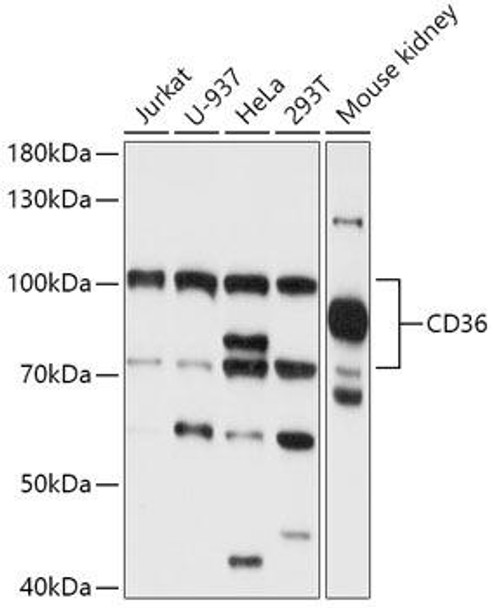
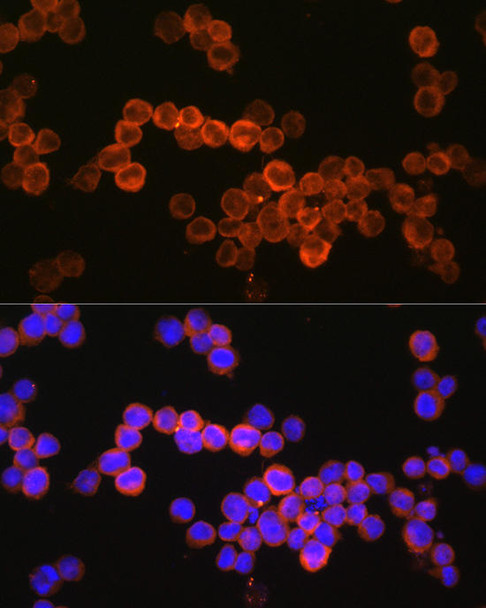



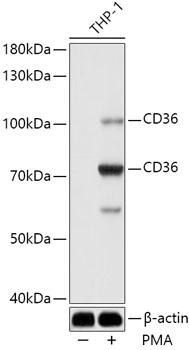

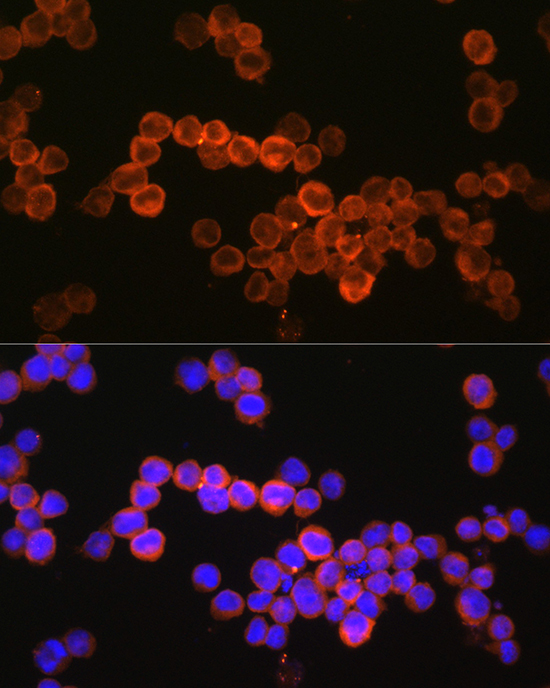
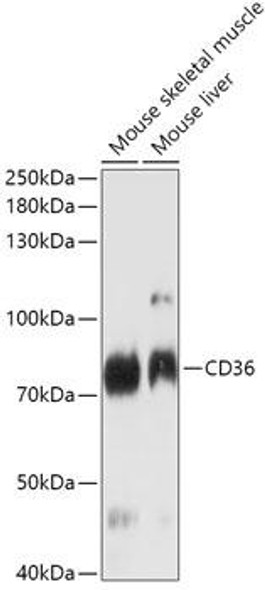
![APC Anti-Mouse CD36 Antibody [HM36] (AGEL3301) APC Anti-Mouse CD36 Antibody [HM36] (AGEL3301)](https://cdn11.bigcommerce.com/s-h68l9z2lnx/images/stencil/590x590/products/221422/605645/apc-anti-mouse-cd36-antibody-hm36-agel3301__22734.1707495541.jpg?c=2)
![APC Anti-Mouse CD36 Antibody [HM36] (AGEL3304) APC Anti-Mouse CD36 Antibody [HM36] (AGEL3304)](https://cdn11.bigcommerce.com/s-h68l9z2lnx/images/stencil/590x590/products/221425/605844/apc-anti-mouse-cd36-antibody-hm36-agel3304__74265.1707496146.jpg?c=2)

![GenieFluor 647 Anti-Mouse CD36 Antibody [HM36] (AGEL3305) GenieFluor 647 Anti-Mouse CD36 Antibody [HM36] (AGEL3305)](https://cdn11.bigcommerce.com/s-h68l9z2lnx/images/stencil/590x590/products/221426/605986/geniefluor-647-anti-mouse-cd36-antibody-hm36-agel3305__69630.1707496615.jpg?c=2)
![GenieFluor 647 Anti-Mouse CD36 Antibody [HM36] (AGEL3303) GenieFluor 647 Anti-Mouse CD36 Antibody [HM36] (AGEL3303)](https://cdn11.bigcommerce.com/s-h68l9z2lnx/images/stencil/590x590/products/221424/605833/geniefluor-647-anti-mouse-cd36-antibody-hm36-agel3303__20193.1707496134.jpg?c=2)
![GenieFluor 488 Anti-Mouse CD36 Antibody [HM36] (AGEL3302) GenieFluor 488 Anti-Mouse CD36 Antibody [HM36] (AGEL3302)](https://cdn11.bigcommerce.com/s-h68l9z2lnx/images/stencil/590x590/products/221423/606623/geniefluor-488-anti-mouse-cd36-antibody-hm36-agel3302__18608.1707498653.jpg?c=2)
![APC Anti-Human CD36 Antibody [5-271] (AGEL1824) APC Anti-Human CD36 Antibody [5-271] (AGEL1824)](https://cdn11.bigcommerce.com/s-h68l9z2lnx/images/stencil/590x590/products/22355/606335/apc-anti-human-cd36-antibody-5-271-agel1824__68999.1707497704.jpg?c=2)